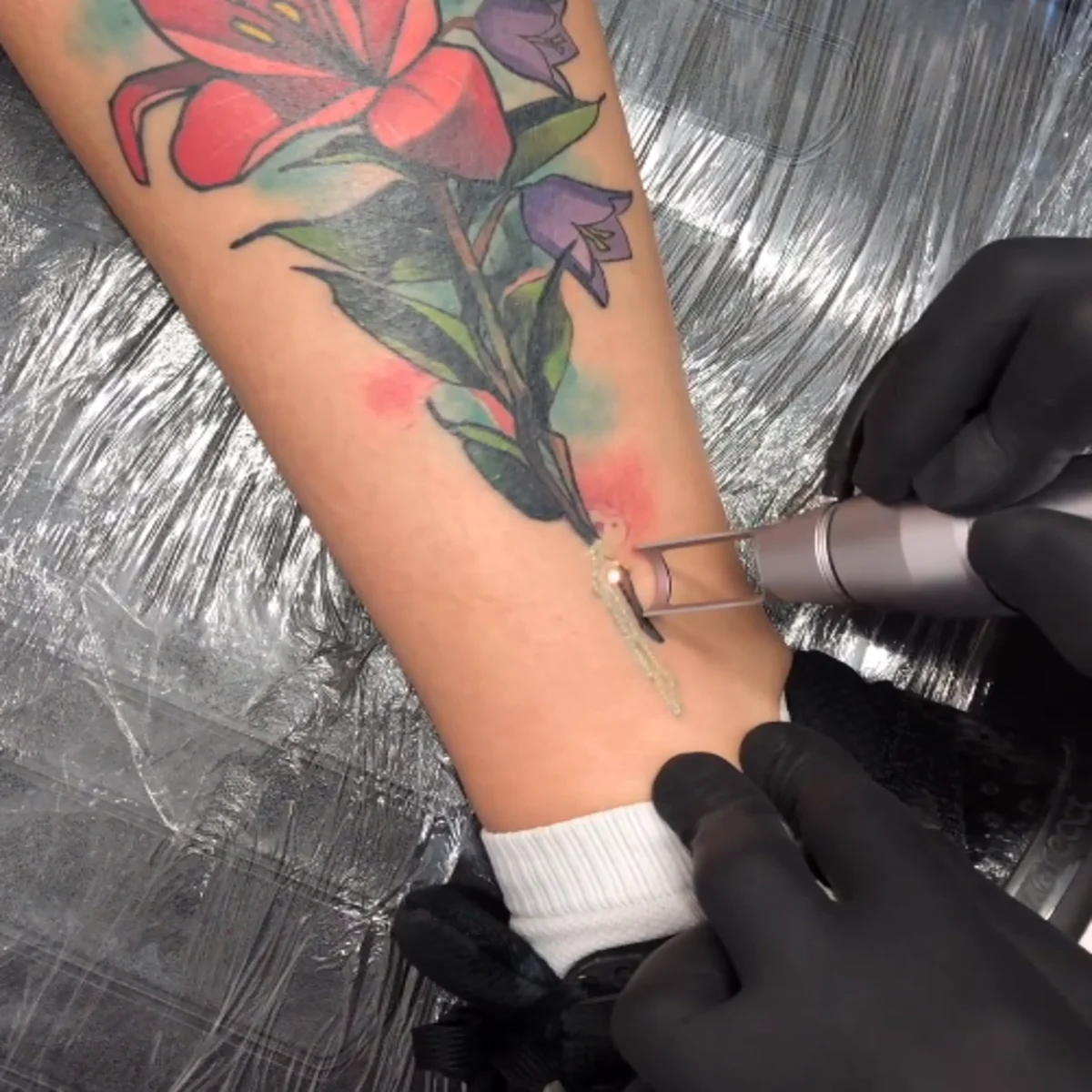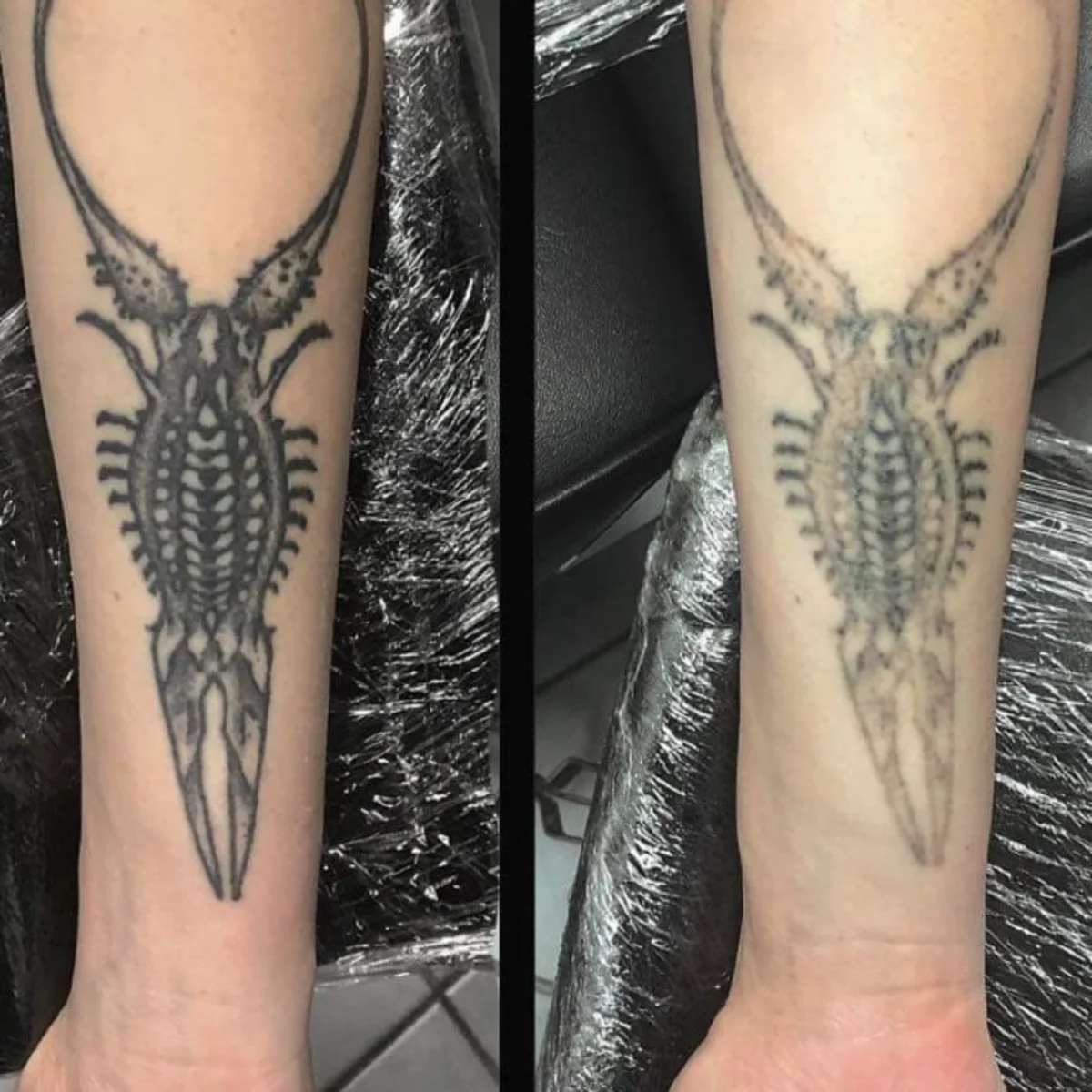Tattoo laser removal procedures involve directing laser light onto the tattoo, with the laser wavelength adjusted based on the ink colour. Darker inks like black are typically easier to remove or fade.

How does laser tattoo removal work?
Laser tattoo removal has become more efficient and effective, offering hope for those with tattoo regret.
Can you explain how laser tattoo removal works?
Understanding how tattoo ink becomes permanent is necessary before addressing the question.
What makes tattoos permanent?
When a tattoo is applied, the ink is injected into the deeper layers of the dermis, where it remains as the outer layers of the skin regenerate.
During the healing process after getting a tattoo, skin cells repair around the ink particles, which are too large for white blood cells to absorb. This results in the tattoo ink becoming permanently etched into the skin.
Tattoo removal process
Laser tattoo removal is when a trained practitioner uses a laser on the tattoo area, emitting short pulses of intense light energy.
Light energy pulses go through the skin layers and are absorbed by tattoo ink. The intense energy causes the ink particles to heat up and fragment quickly.
During treatment, ink particles from the tattoo are flushed into the lymphatic system and eventually expelled through urine. The tattoo will gradually fade with multiple treatments until the maximum amount is removed.
Can coloured tattoos be removed?
Coloured ink was historically challenging to remove with older laser technology, but advancements like the PicoSure and RevLite lasers now enable precise targeting and near-complete removal of all colours.
Various colours of tattoos absorb and reflect light wavelengths differently, requiring the use of different wavelengths like 532nm, 755nm, and 1064nm for removal.
Stubborn greens and blues can be effectively treated with PicoSure laser technology.
Laser tattoo removal results may vary
Laser tattoo removal typically requires multiple sessions, usually between 2 and 10 or more, to entirely remove or fade a tattoo. Sessions need to be spaced at least six weeks apart to ensure optimal results and allow for proper healing of the skin. The number of sessions required may vary depending on the size and colour of the tattoo.
In laser tattoo removal treatments, the top layers of tattoo ink absorb the laser energy, while the deeper layers may not be affected. Subsequent sessions target the deeper layers after the top layers have been shattered and removed by the immune system, leading to the gradual fading and lightening of the tattoo with each treatment.
Allowing adequate time for your body to eliminate the fragmented ink particles between tattoo removal treatments is recommended. This will optimise the results of each session and minimise the risk of adverse reactions.
Is laser tattoo removal painful?
There is a common belief that laser tattoo removal is excruciating. Still, many clients find it less uncomfortable than anticipated, often comparing it to the sensation of getting a tattoo.
Our clinic utilises a cooling system to cool the skin during laser tattoo removal and may apply a local anaesthetic for those with high pain sensitivity to reduce discomfort.
Our technicians utilise advanced laser technology to cover large areas efficiently. A session can take less than 30 minutes for a large tattoo and just a few minutes for a small cosmetic eyebrow tattoo.
Coloured tattoos may require more time for removal, as the laser wavelength must be adjusted to target various colours.
How safe is laser tattoo removal?
Laser removal is widely recognised as a safe method for tattoo removal, with minimal risk of side effects or complications when done by a trained technician.
At B Clinic, a thorough medical history will be taken during your free consultation to assess your eligibility for laser treatment. Laser tattoo removal is a non-invasive procedure generally suitable for most healthy adults.

Does tattoo removal scar?
When performed by a trained technician, laser tattoo removal typically carries a low risk of scarring. However, pre-existing skin scars from the initial tattoo application may become more visible as the ink is removed.
Following the aftercare instructions is crucial to maintaining skin health and minimising scarring after laser treatments.
Aftercare
Following a laser tattoo removal session, individuals may experience mild redness, swelling, and tenderness, commonly likened to mild sunburn's effects.
Refraining from prolonged sun exposure, heat, and swimming between treatments is essential. It is also recommended to avoid strenuous exercise, hot showers, or saunas during the first few days after treatment or until the skin has healed.
The tattoo healing process is easier and more manageable than the initial application.
Better laser tattoo removal techniques
B clinic uses advanced laser technology for tattoo removal, which is now more effective and gentle on the skin.
The lasers emit brief pulses of light energy to target tattoo ink particles without harming surrounding skin cells.
Short pulses of light energy are used to break down tattoo ink particles without causing damage to the surrounding tissue.
What are the alternatives to laser tattoo removal?
Laser tattoo removal is commonly used to remove unwanted tattoos without surgical procedures.
Two options for achieving similar results include undergoing surgery or powerful CO2 laser treatments, both of which can lead to painful side effects and scarring.
Various tattoo removal creams and serums are available on the market, but there is no scientific evidence to prove that these products effectively remove tattoo ink. Topical creams cannot reach the deep layer of the skin where tattoo ink is applied.
Laser tattoo removal is a commonly used method for removing unwanted ink.